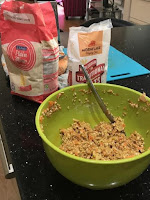May 2020
On Saturday afternoon we spent a few hours giving ourselves a technical challenge and thought it would be great to experiment in the kitchen and produce some delicious treats for our ponies. The shop bought treats as like anything you buy for equines are often expensive and often dry and full of sugar. It was a fun filled afternoon for me and the children and also great to experiment with our own ingredient combinations to produce low sugar treats.
Needless to say, the ponies loved their treats.
It is my intention after many more trial runs, when the treats are made to perfection, to produce and sell pony and dog treats through my website early next year.
There are always jobs and/or repairs or fixing to be done - Gary is adding a new horse tie ring to Patch's stable for her rock salt to hang. Being a Shetland she can't reach the one that was previously in place.
On Sunday morning we restored "drinking baths" that had been left in our fields for years! They were full of stagnant water, leaves, insects, very rusty and needed a dam good clean!
 |
| Helping hands |
 |
| The end result |
COLIC -
In addition to general changes in behaviour a horse with colic may show some of the following signs:
- Restlessness and pawing at the ground
- Sweating and increasing breathing rate
- Irritated kicking to the stomach
- Stretching as it to urinate
- Rolling or attempting to roll
- Elevated pulse rate
Colic should be treated as an emergency and the vet should be called as soon as possible.
Whilst waiting for the vet to arrive -
Always wear your hat and gloves -
Create a safe area
- If your horse is in severe pain( trying to roll ) put them in a safe area such as a bedded stable with a head-collar and lead rope or keep hold of them. If in an arena us a lunge line to keep control of them to prevent any additional injuries..
- Take out any buckets or objects that they may injure themselves son and leave them quietly until the vet arrives.
- It can be distressing to watch - it is advised not to enter the stable until the vet arrives to help prevent you being hurt.
Exercise
- If your horse is in significant pain - gentle walking for 15 or 20 minutes can help and will not do any harm.
- Horses must not be exercised at a trot or a canter and should not be walked longer than the above time unless under instruction from your vet.
- Do not force your horse to walk around if they are trying to get down.
- Exercising a horse that is sick will exhaust them and if the have a serious form of colic that requires surgery, this will not help their recovery from anesthesia.
Feed and Water -
- Always check with your vet.
- Remove any feed from their stable. Horses that are standing quietly in their stable can have water left with them; although a sick horse is not likely to drink.
- Provide your vet with good directions to your property and a contact number
- If its hard to find have someone stand by the road or gate or use a defined landmark to assist.
- Have a plan in place should your horse need to go to a clinic
- Check if using your own trailer or horse box there are no flat tyres and that it will actually start.
- Check that colic is covered under your insurance.
Whilst I have talked about colic developing from restricted water. There are different types of colic that can develop from the following -
- Spasmodic - due to feeding/management changes, worms, stress, heat ans drinking very cold water.
- Impaction - similar to constipation. May be due to a dry diet dental disease, reduced water intake or box rest.
- Displaced/twisted intestines - may require surgery
- Other less common causes such as tumors, infections, liver diseases, grass sickness and gastric ulcers.
Whilst this can also be very distressing for owners to witness you must be able to recognize the signs. I have a fact sheet clearly displayed in my stables along with my veterinary practice details and contact numbers.










Comments
Post a Comment